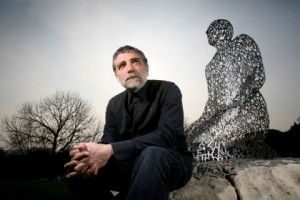
When a bronze gong is struck in the middle of an art gallery, does it make a sound? Well, according to Catalan artist Jaume Plensa, that might depend on you. The solemn clang of his well known work Jerusalem is not so much an aural phenomenon as a vibration of the heart.
There are 11 gongs in a darkened room, waiting for a visitor to become number 12. They are suspended next to malletas and inscribed with text from the Biblical Song of Songs. One might also ask if the sound of the ancient instrument is the reason one strikes it, and not vice versa. Plensa seems keen on poetic logic.
“I have said many times that for me sculpture is the best way to pose a question – that is, the most conceptual way,†says the softly spoken artist. His serious mood is amplified by the ten monumental alabaster heads in the gallery where I speak to him. They radiate solemnity.
“But on other levels sculpture has a tremendous capacity to talk about abstraction,†Plensa continues. He says it is so difficult to create portraits with sculpture that sculptural gestures are more conceptual than concrete.
“Attitude is key,†he adds, “because you are not only talking about materials but also ethics, philosophy, the nature of religion. Whatever is part of the human condition is part of the sculpture and that I guess is very interesting to my way of working.â€
So like any decent gong, sculpture depends on what the viewer brings to the party. There go the laws of objectivity again. In Plensa’s hands reason is as soft as alabaster and as malleable as one of the many lines of poetry he gives three-dimensional form to in this show.
Given the ancient appeal of these deity-like Alabaster Heads, it comes as a surprise to learn that here, as elsewhere in his work, computer modelling has been used to elongate the forms. And when I ask about the extensive use of technology in his work, the answer is also unexpected.
Technology, he argues, is, like sculpture, just a means of enquiry: “What spirituality means is to continue to try to think about the main questions generation after generation. Technology is probably the vehicle that every generation is using to ask those questions.â€
Plensa mentions a recent visit to York Cathedral as an example of a previous form of hi-tech, and mentions the standing stones at Carnac in Britanny as an example of applied repetition. Rhythm in sculpture does for the brain what in music it does for the body. “It helps you to concentrate,†he says.
The alabaster heads number ten or so and do indeed focus the mind. Rhythm here leads to a feeling of timelessness. “I’m also emphasising the repetition because my intention was to create something like old museum pieces coming from we don’t know where.â€
It should be pointed out that many other works by this sculptor have contemporary written all over them. In adjacent galleries are luminous fibreglass creations: In the Midst of Dreams and Hear No Evil, Speak No Evil, See No Evil. Outdoors are more virtually dreamed up sculptures comprised of grids and alphabets, including the eight-metre high figure House of Knowledge.
However, Plensa insists, “the piece should not be for today, it should be forever.†And this is not, he adds, “in terms of preservation of materials because I love also ephemeral things. No, it’s a concept – because when you are in front of things you get this flash of eternity.â€
It is not unlike Plensa to quote a writer to make his point: “I like very much the explanation that William Faulkner said once. He said ‘I could not accept that people were put in the world only to endure – we are here to prevail.’ And I like that as a concept in sculpture.â€
Perhaps there’s even an echo of Faulkner’s novel, Wild Palms, in the 58-metre sculpture Twenty-Nine Palms. This showstopper is made from 17,000 stainless steel letters which spell lines from a range of the artist’s favourite authors. Plensa trails a hand across the curtain to demonstrate the jangle.
So if a breeze disturbed this work in a gallery with no one around to hear, would it still make a sound? Well, that depends…
Written for Culture24. Jaume Plensa was interviewed at Yorkshire Sculpture Park, Wakefield, where his show runs until 25 September 2011. See gallery website for further details.
Hello Mark
Thought you might not have seen Our Vintage by Hemingway retro type prints?
Hope you like them on display at Green and Fay until mid may.. Helen
http://www.eastendprints.co.uk/content/vintageHemingway
Thank you Helen, I suppose his Random Letters look a little bit a Jaume Plensa sculpture, but otherwise the connection to this post is a bit tenuous!